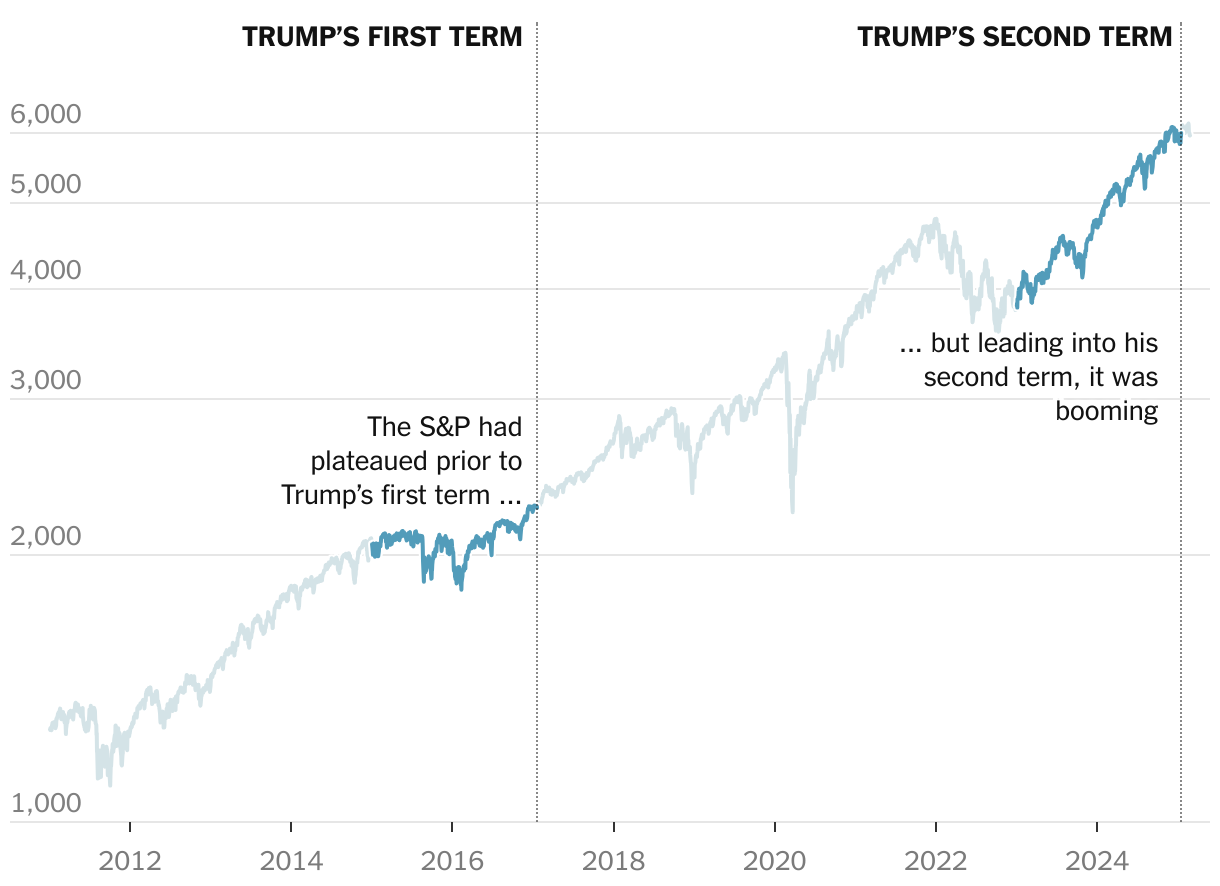
Dow Drops 800 Points as Trump Confirms Tariffs on Mexico and Canada Will Begin Tuesday
US stocks plunged Monday as investors braced for the implementation of President Donald Trump’s highly anticipated tariffs on Canada, Mexico, and China, set to take effect at midnight. The Dow Jones Industrial Average sank 830 points, or 1.9%, marking a sharp decline. The broader S&P 500 dropped 2.2%, while the Nasdaq Composite fell by 3%.
During a press conference at the White House, Trump confirmed that the tariffs would start immediately, with a 25% tariff on both Canada and Mexico. “Tomorrow, tariffs — 25% on Canada and 25% on Mexico,” Trump stated. “What they have to do is build their car plants, frankly, and other things in the United States. If they do that, there will be no tariffs.”
Trump’s remarks caused an immediate spike in the Volatility Index (VIX), Wall Street’s “fear gauge,” which surged to its highest level of the year. The President emphasized that the two neighboring countries had “no room” left to negotiate and that he was using tariffs as a method of punishment for what he described as countries that have been “taking from the US economy without giving enough in return.”
“Tariffs are set, and they’ll go into effect tomorrow,” Trump affirmed, leaving little doubt about the impending policy shift.
Commerce Secretary Howard Lutnick also spoke at the press conference, explaining that global companies could avoid the tariffs by investing in US-based production, using Taiwanese chipmaker TSMC’s $100 billion investment as an example.
While analysts at Goldman Sachs noted that these tariffs would likely raise the cost of imported goods and, in theory, boost demand for US-made products, they also warned that such measures could have detrimental effects on American businesses. Shipping costs would rise, and the tariffs could lead to retaliation from foreign countries, further hurting US exports.
“While the tariffs could boost domestic production in some sectors, they could also increase costs for US manufacturers and provoke foreign retaliatory actions that may hurt exports,” the analysts warned in a note to clients.
As the day wore on, stock prices continued to slide, reflecting investor concerns over the broader economic impact. Jason Draho, head of asset allocation for the Americas at UBS Global Wealth Management, noted that the market was likely to remain volatile until Trump’s policies shift toward more growth-focused strategies. Despite the volatility, Draho maintained a positive medium-term outlook for the economy.
The selloff on Wall Street began early in the day, triggered by the latest manufacturing survey from the Institute for Supply Management. Although the survey showed the manufacturing sector remained in expansion territory, it also highlighted a slowdown in growth. Many responses to the survey pointed to tariff-related uncertainties as a key concern for businesses.
“Customers are pausing on new orders due to the uncertainty surrounding tariffs,” one survey respondent stated. “There’s no clear direction from the administration on how they’ll be implemented, making it difficult to project their impact on business.”
Markets worsened later in the afternoon after Trump posted a message on his social media platform, Truth Social, signaling that additional tariffs could target agricultural products. While details were unclear, Trump suggested that these tariffs could be imposed on “external products” starting April 2.
“To the Great Farmers of the United States: Get ready to start making a lot of agricultural products to be sold INSIDE of the United States,” Trump wrote. “Tariffs will go on external products on April 2nd. Have fun!”
As investors digested these latest developments, the prospect of a trade war and the uncertainty surrounding tariff enforcement weighed heavily on market sentiment. The market’s direction in the coming days will likely depend on how the tariffs are implemented and whether foreign governments retaliate, triggering a broader economic impact.
In the meantime, the situation remains fluid, with many analysts predicting more turbulence ahead as Trump’s aggressive trade policies unfold. The coming days will be critical in determining whether these tariff measures will lead to long-term economic shifts or merely further disruptions to global trade.